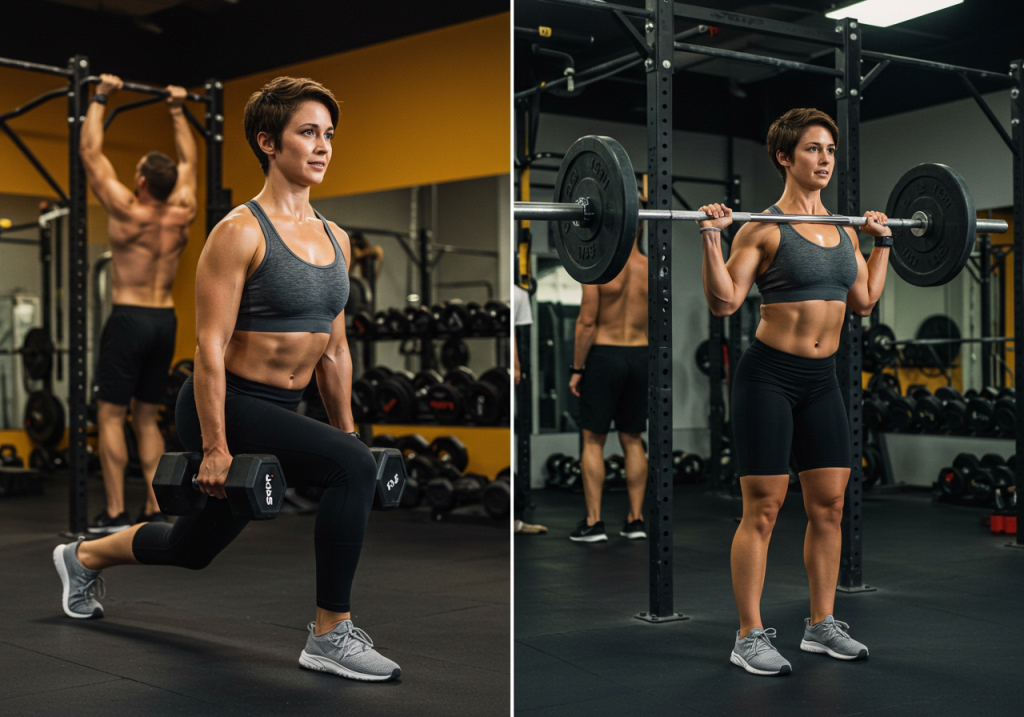What Should I Know About Different Training Splits?

When it comes to crafting the perfect workout routine, understanding training splits can feel like unlocking a secret code to fitness success. So, what should I know about different training splits? Let’s start with the classic full-body split—a timeless favorite that’s all about efficiency. Picture yourself as an artist with a wide canvas: in a single session, you’re brushing over every major muscle group, from your chest and back to your legs and arms. Typically done two to three times a week, this method is a goldmine for beginners or anyone aiming to keep their strength and muscle balance in check. Why focus on just one corner of the masterpiece when you can cover the whole thing in one go? It’s practical, time-saving, and sets a solid foundation for long-term growth.
Now, let’s pivot to the push/pull/legs split—a game-changer for those ready to take their training up a notch. Imagine sorting your wardrobe into neat piles: push exercises like bench presses and shoulder presses stack up on one day, targeting your chest, shoulders, and triceps. Then, pull day rolls in, hitting your back and biceps with moves like rows and pull-ups. Finally, legs get their own spotlight with squats and deadlifts. What should I know about different training splits like this one? It’s ideal for intermediate or advanced lifters who want to zero in on specific muscle groups while giving their body ample recovery time. It’s structured, focused, and perfect for building strength without burning out.
Next up is the upper/lower split—a balanced approach that’s like splitting your week into two distinct vibes. You’ve got two days dedicated to upper body—think chest, shoulders, back, and arms—and two days for lower body, hammering those quads, hamstrings, and glutes. What should I know about different training splits like this? It’s a fantastic middle ground if you’re looking to increase intensity without overcomplicating your schedule. Your muscles get a solid workout, followed by enough downtime to recover and grow, making it a go-to for folks who want progress without chaos.

Then there’s the body part split, a favorite among bodybuilders and anyone chasing serious muscle gains. Think of it like zooming in on one instrument in a symphony—each day hones in on a single muscle group, like chest on Monday, back on Tuesday, and so on. What should I know about different training splits like this? It’s all about precision. You can pour extra energy into each area, making it perfect for targeting weaknesses or sculpting a physique that turns heads. The catch? It often requires more days in the gym, so it suits those with flexible schedules and a passion for detail.
The beauty of training splits lies in their flexibility—there’s no one-size-fits-all. What should I know about different training splits to pick the right one? It’s about aligning your routine with your goals, lifestyle, and experience level. Whether you’re sketching a broad outline with full-body workouts or fine-tuning with a body part split, each approach brings you closer to your fitness masterpiece. So, what’s your next move?
Unlock Your Fitness Potential: A Beginner’s Guide to Training Splits
Diving into fitness can feel overwhelming, but training splits are here to simplify the process. So, what should I know about different training splits as a beginner? At its core, a training split is how you organize your workouts across the week. Instead of tackling every muscle group daily—which can leave you juggling too much and dropping the ball—splits let you focus on specific areas at a time. One day might be all about your upper body, while the next hones in on your legs. It’s like breaking a big project into manageable chunks, giving you clarity and purpose.
Why does this matter? Recovery, for one. When you zero in on certain muscles, the others get a breather, rebuilding stronger for the next round. What should I know about different training splits and their benefits? They help you avoid exhaustion while speeding up progress—two things every newbie craves. Plus, targeted workouts keep things exciting, which is key when you’re just starting out and need that extra push to stay motivated.
Let’s map it out: how about a three-day split to kick things off? Day one could focus on chest and triceps with moves like push-ups and dips. Day two shifts to back and biceps—think bent-over rows and curls. Then, day three is all about legs and core, with squats and planks stealing the show. What should I know about different training splits like this? They strike a sweet balance—enough work to spark growth, enough rest to keep you fresh. As you get comfortable, you can tweak it, maybe adding a fourth day or mixing up the exercises. Grab your gear, stay consistent, and watch your inner fitness star shine!

Maximize Gains: The Best Training Splits for Your Goals
When your sights are set on muscle gains, picking the right training split is like choosing the perfect recipe—it’s all about the right ingredients for your goals. So, what should I know about different training splits for maximizing gains? If hypertrophy is your aim, the push/pull/legs split might just be your secret weapon. Picture it as a three-course meal: push days fuel your chest, shoulders, and triceps with presses and dips; pull days nourish your back and biceps with rows and chin-ups; and leg days build a rock-solid base with squats and lunges. It’s a well-rounded feast that keeps your muscles growing without overloading any one area.
Short on time but still chasing gains? Full-body workouts might be your ace in the hole. What should I know about different training splits like this? They’re like a power-packed smoothie—everything you need in one go. You hit all major muscle groups in a single session, making it a time-saver that still delivers results. It’s perfect for busy schedules or anyone who wants to keep things simple yet effective.
For seasoned lifters with bigger ambitions, a body part split could be the ticket. Imagine dedicating an entire session to your chest—bench presses, flyes, the works—then giving it a full week to recover while you tackle other areas. What should I know about different training splits tailored for advanced goals? This method lets you push each muscle to its limit, ideal for sculpting size and strength. Your goals dictate the split, so whether you’re bulking up or refining, there’s a path to maximize those gains.

From Full-Body to Push-Pull: Decoding the Most Popular Training Splits
Training splits come in all flavors, and two of the most popular are full-body and push/pull. So, what should I know about different training splits like these? Full-body workouts are the all-you-can-eat buffet of fitness—every session works your entire body, from head to toe. It’s a brilliant choice if you’re new to the gym or pressed for time, building strength and stamina that make everyday tasks a breeze. Plus, hitting every muscle group multiple times a week keeps your metabolism humming—a win for fat loss and overall fitness.
On the flip side, the push/pull split is more like a curated playlist, splitting your efforts into two focused streams. Push days target your pressing muscles—chest, shoulders, triceps—while pull days work your pulling powerhouses—back and biceps. What should I know about different training splits like push/pull? They offer laser focus, letting you hammer specific movements while giving worked muscles a solid break before their next turn. It’s efficient and reduces wear-and-tear, making it a staple for lifters who love structure.
Both approaches shine in their own way, and your choice depends on your vibe. Full-body keeps it broad and versatile; push/pull zooms in with precision. What should I know about different training splits to decide? Consider your schedule, goals, and how your body feels—then pick the one that fuels your journey best.

The Science Behind Training Splits: Which One is Right for You?
There’s a bit of science behind why training splits work so well, and it all boils down to recovery and focus. What should I know about different training splits and their logic? If you’re new to lifting, full-body workouts lay the groundwork—like pouring a strong foundation for a house. They hit every muscle group, building overall strength and coordination without overwhelming you. Research backs this up: beginners see faster gains with frequent, moderate stimulation.
For those with some gym miles under their belt, a two- or three-day split might be the sweet spot. What should I know about different training splits for intermediate lifters? These let you crank up the intensity on specific areas—say, chest and triceps one day, back and biceps the next—while giving other muscles a rest. Studies show this balance of work and recovery boosts muscle growth, especially as your body adapts to heavier loads.
Aiming for a chiseled look? An upper/lower split could be your match. What should I know about different training splits for aesthetics? It gives your upper and lower body dedicated days, blending intensity with recovery time. Science says this frequency—hitting each muscle twice a week—optimizes hypertrophy. Your perfect split hinges on where you’re at and where you’re headed, so experiment and see what clicks.
Training Splits Explained: How to Tailor Your Workout Schedule for Optimal Results
Training splits are all about working smarter, not just harder. What should I know about different training splits for tailoring my routine? Think of your muscles as sponges—they soak up effort during workouts, then need time to dry out and strengthen. A split lets you focus on one area, like upper body, while legs chill, then swap it the next day. This keeps you from frying out and ensures each muscle group gets its moment to shine.
How do you craft the perfect split? Start with your life and fitness level. Beginners might thrive on a three-day full-body plan—simple, effective, and easy to stick with. Seasoned lifters could opt for a push/pull/legs setup, diving deep into each group for targeted gains. What should I know about different training splits and frequency? More days—like a four- or five-day split—let you push harder per session, sparking growth over time. It’s like leveling up: the more you focus, the bigger the payoff. Assess your goals, test a split, and tweak it until it fits like a glove.

Revolutionize Your Routine: Exploring the Benefits of Different Training Splits
Ready to shake up your workouts? Training splits might be your ticket. What should I know about different training splits and their perks? Take push/pull/legs—you work different muscles each day, giving them a break while others step up. It’s like rotating crops in a garden: everything grows stronger without wearing out the soil. This split builds muscle and strength without leaving you drained.
Upper/lower splits are another gem, especially if you’re juggling a busy life. What should I know about different training splits like this? They target big muscle groups—upper one day, lower the next—with shorter, punchy sessions that still deliver. Your muscles recover while you keep the momentum going, perfect for steady gains on a tight schedule. Whatever split you choose, it’s about finding what fires you up and fits your flow.
Overtraining vs. Undertraining: Finding Balance Through Training Splits
Training splits are your roadmap to avoiding the twin traps of overtraining and undertraining. What should I know about different training splits for balance? Instead of pounding every muscle daily— risking fatigue and injury—you spread the love across the week. Chest and triceps one day, legs the next—it’s a rhythm that keeps you strong without breaking you down.
Ever felt stuck, like you’re not doing enough but still not seeing results? That’s undertraining creeping in. A smart split, like push/pull/legs or upper/lower, ensures every muscle gets its due without leaving you guessing. What should I know about different training splits to stay in the zone? Listen to your body, adjust your effort, and aim for that sweet spot where challenge meets enjoyment. Ready to find your balance and crush it?





